I had been wanting to try my hand at DMing in Japanese for a long time, but always found an excuse to wait. That procrastination finally came to an end when the regular DM for the monthly D&D 5e game I play in suddenly had to work. The group considered playing something else, but at the coaxing of my wife, I volunteered to run a one shot. Both the game and prep were fun, so it was definitely worth the challenge! I hope to inspire others to try DMing in a second language by diving into how I went about prepping and running the game.
Prep!
Having only a day to prepare was surprisingly useful because it forced me to focus on the most important tasks.
The Scenario
 First, I decided that I’d use a pre-written scenario and after some research, settled on “A Starry Breach” from Kobold Press’s Prepared! 2. I already had their Tome of Beasts, so ran the monsters as written, but there are suggested replacements from the Monster Manual as well. Next, I printed out the three pages of the adventure and monster entries and sleeved them in a folio for easy reference. Scenario to run now in hand, I had one problem: it was in English, but the game would be in Japanese.
First, I decided that I’d use a pre-written scenario and after some research, settled on “A Starry Breach” from Kobold Press’s Prepared! 2. I already had their Tome of Beasts, so ran the monsters as written, but there are suggested replacements from the Monster Manual as well. Next, I printed out the three pages of the adventure and monster entries and sleeved them in a folio for easy reference. Scenario to run now in hand, I had one problem: it was in English, but the game would be in Japanese.
Language

Rather than trying for a precise translation, I went with a looser, more improv method. After reading the English scenario for content, I again skimmed it for keywords and phrases I wanted to focus on or that often appeared. For example, how to say “void” (空白) or describe “ice spires” (氷の尖塔 and 氷筍). If I wasn’t sure how to translate, I added the word or phrase to a notes file, one word with definition per line. I then printed this and sleeved it at the back of the folio for easy reference during the game. Making it also helped reinforce the new vocabulary, so I actually only ended up referencing it a few times.
The reason for this approach was that I could rephrase the English in Japanese with words I know, occasionally dipping into the new vocabulary where it was important. This led to a much shorter prep time and smoother session.
The Characters
I thought about using the characters from the starter set, but wanted to give the players a chance to try different characters. The adventure was for characters level two to three, so decided on level two to keep things simple. I originally planned to create each character myself, but pressed for time, looked online for pre-gens. I was rewarded with great pre-gen characters on dndwh0, a wiki for all things D&D in Japanese.
One of the cool things about these pre-gens is that they include all the information needed to use them on the sheet itself. It’s a custom sheet and information dense, but it lists spells, abilities, and has helpful hints on how the character can be played. One player graciously volunteered to play two characters, so I selected four characters: a half-orc barbarian, a tiefling warlock, a human cleric, and a human fighter.

Miniatures
I usually run combat in my online 5e game as theater of the mind, but I knew I wanted miniatures for this one shot. First of all, the players were already used to them from our regular game. Second, and more importantly, it would help them visualize and reduce the need for accurate spatial descriptions in Japanese.
While I have some 3D fantasy miniatures, I didn’t have enough for an entire party, so decided to go the paper miniature route. Using binder clips for the base, I printed out heroes from Hobby Japan’s support site on photo paper. For the monster minis, I printed out their image from the Tome of Beasts PDF. Things were starting to come together nicely.

The Map
 Next, I opened the included map for the adventure in Affinity Photo and modified the size so that it could be printed on four A3 pages. The spaces ended up a bit smaller than normal, but it was a good compromise because it otherwise would not have fit on the table.
Next, I opened the included map for the adventure in Affinity Photo and modified the size so that it could be printed on four A3 pages. The spaces ended up a bit smaller than normal, but it was a good compromise because it otherwise would not have fit on the table.
I didn’t account for the portion of the map not being printed between pages, so my wife and I colored in the spaces with watercolor pencils.

Initiative cards
I’m fond of dry erase initiative cards, so created some using soft plastic A7 card holders from the 100 yen shop. Adapting some templates I found online, I printed out and sleeved them in card holder. I’m planning on refining a bit more, but the main changes were to translate from English to Japanese and reduce the number of fields.
Miscellaneous Sundries
 Other handy items were small plastic paper index clips that could be placed on the map or pinned to minis. A copious amount of clear files, dry erase markers, and a Paizo dry-erase battle mat also made it to the table with me.
Other handy items were small plastic paper index clips that could be placed on the map or pinned to minis. A copious amount of clear files, dry erase markers, and a Paizo dry-erase battle mat also made it to the table with me.
The Game

Running the game itself was pretty straightforward . I gave an overview of the setting (I chose to make it even farther North than Icewind Dale) and that their party had been hired to check on an outpost gone silent. They started in an establish party, so to help get the players into their characters, I asked each player for why their character joined.

The party tiefling joined to escape discrimination and invited the half-orc to join the party for similar reasons. The cleric was just a really good person at heart, wanting to help people. And finally the fighter wanted to be a hero and looked up to the cleric as an example. The rallying cry of the party became “no discrimination” (ノー差別) and the wanna-be hero fighter named the party “Drizzt” because Drizzt’s Companions were all types of people. Plus, he really, really wanted to be a hero like Drizzt.

Off to the battle maps
I used a Paizo dry erase battle map for the initial scene at the outpost, detailing the map as they got closer and finally entered the outpost. The highlight, though, was when the printed battle map came out. It definitely raised the level of excitement.

My players said they really enjoyed the adventure and liked the balance between exploration and combat. They also liked the rational explanations for what and why things were happening.
Language

I struggled at times with describing certain things, but overall it went well. Despite the uniqueness of some of the creatures, the players understood my descriptions and helped fill in words when I needed help, such as forgetting the word for feeler/tentacle (触手). It was a very rewarding experience that gave me the confidence to try it again in the future. While being the DM in a second language can be daunting, the ability to shape the conversation with words you know can actually make it easier in some regards.
Bonus Box
I loved the folding box one of the players had so much that I picked up a navy blue one of my own. For those interested in their very own box, it’s a “Box M-size” in the “Lifestyle Tool” series by Nakabayashi.



This is an amazing story of a gameplay. I loved it!
I have the same type of fear because I speak Portuguese native and I dedicate myself to improve my English. Maybe one day I could run or join a game in another language.
Thank you for your kind words! I’m glad you enjoyed it.
It’s definitely intimidating to start gaming in a foreign language, but I’ve found it very rewarding. I hope you get a chance to game in English. At the very least, it makes for some interesting vocabulary not found in normal textbooks. One of the nice things about playing a game you’re already familiar with in a foreign language is that the rules help provide context and a framework to understand what is going on.